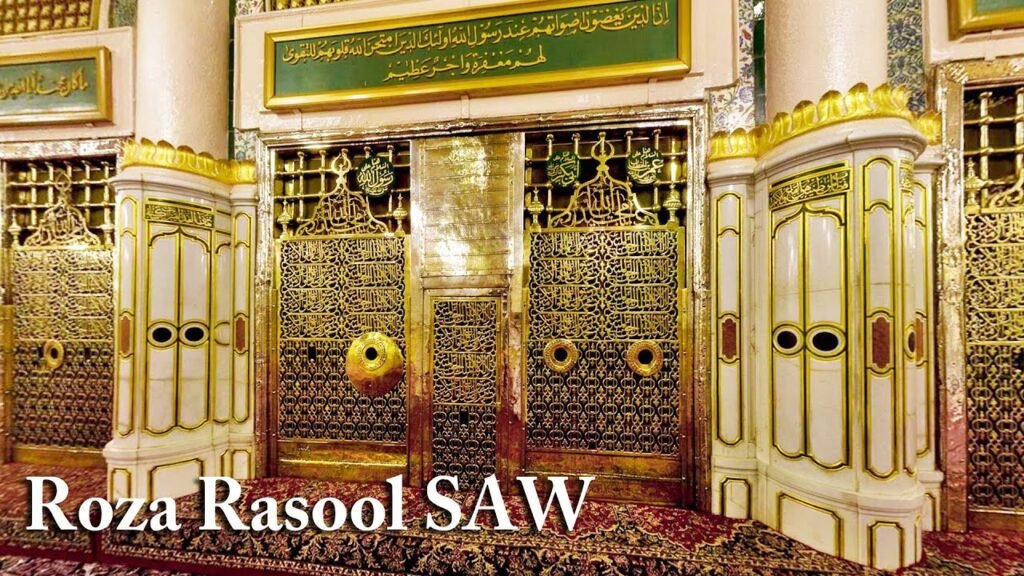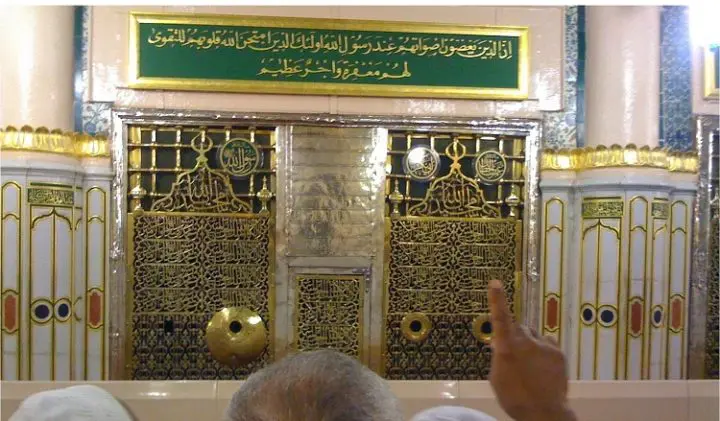The Resting Place of Prophet Muhammad ﷺ
- The Roza Rasool, the final resting place of Prophet Muhammad ﷺ, is located within the expansive Masjid al-Nabawi in Medina, Saudi Arabia.
- This sacred space holds immense spiritual significance for Muslims around the world, drawing millions of pilgrims annually.
- The grave of Prophet Muhammad ﷺ is the focal point of this hallowed site, which was once the humble abode of his beloved wife, Aisha (may Allah be pleased with her).
The History of Roza Rasool
- In 632 CE, Prophet Muhammad ﷺ passed away and was laid to rest in Aisha’s (may Allah be pleased with her) home.
- Over the centuries, this dwelling has been incorporated into the ever-expanding Masjid al-Nabawi, with the Prophet’s ﷺ final resting place becoming the center of this sacred space.
- In the years following the Prophet’s ﷺ death, his close companions Abu Bakr and Umar ibn al-Khattab (may Allah be pleased with them) were also interred alongside him, creating a trio of revered Islamic figures within Roza Rasool.

The Sealed Chamber
- To protect the sanctity of this space, Caliph Umar ibn Abdul Aziz ordered the chamber housing the Prophet’s ﷺ grave to be sealed in 710 CE.
- This measure was aimed at preventing unauthorized access or disturbance to the Prophet’s ﷺ final resting place.
- The walls of the sealed chamber were later reinforced by the Sultan Nur-ud-din Zangi, who filled them with molten lead to deter any attempts to steal the Prophet’s ﷺ body.
The Golden Grill
- The Roza Rasool today is surrounded by a magnificent golden grille, allowing pilgrims to catch a glimpse of this hallowed site and offer their salutations from a respectful distance.
- The largest opening in the grille faces the grave of Prophet Muhammad ﷺ, while the two smaller openings face the graves of Abu Bakr and Umar ibn al-Khattab (may Allah be pleased with them).
The Architectural Marvels of Roza Rasool
The green-domed structure towering above the Roza Rasool is a testament to the reverence and care with which this sacred site has been preserved over the centuries. Added in the 19th century by the Ottoman Sultan Mahmud II, this distinctive feature has become a celebrated symbol of Masjid al-Nabawi and a source of immense pride for Muslims worldwide. The dome was later painted in a vibrant green hue in 1837 AD, further enhancing the visual splendor of this hallowed space.
Attempts to Desecrate the Sanctity of Roza Rasool
Despite the extensive measures taken to protect the Roza Rasool, it has not been immune to the attempts of those who sought to desecrate this sacred site. In 1162 AD, there was a brazen attempt to steal the body of Prophet Muhammad ﷺ from his final resting place. This incident highlights the immense spiritual significance of the Roza Rasool and the reverence with which it has been guarded throughout history.
The Anticipation of a Fourth Burial Place

It is said that a fourth place is left in the Roza Rasool, reserved for the eventual burial of Prophet Isa ( peace be upon him). This belief reflects the reverence and anticipation Muslims hold for the return of Prophet Isa to this world, as prophesied in Islamic teachings. The inclusion of this potential fourth burial place underscores the enduring legacy of Prophet Muhammad ﷺ and the unity of the Abrahamic faiths.
Conclusion
The Roza Rasool stands as a testament to the enduring legacy of Prophet Muhammad ﷺ, the final Messenger of Allah. As Muslims from around the world continue to make the journey to Medina to honor this revered site, they reaffirm their commitment to upholding the teachings and principles that the Prophet ﷺ embodied.

